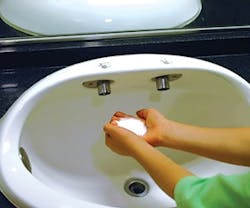Are you receiving complaints about the touchless fixtures in your washroom?
They could be signs that damage has occurred or your installation is incorrect. If you’ve noticed occupants complaining about poorly functioning fixtures, check to see if they have fallen victim to one of these three common pitfalls.
1) Scratched Lenses
Harsh cleaners and abrasive scrubbing media can damage the surface of the fixture’s “eye,” the infrared sensor that detects each user’s presence and operates the fixture accordingly.
This can cause the unit either to not turn on when someone is present or to activate inappropriately by mistaking the scratch for a user, says Jason Renner, senior product manager at Bradley Corp, which manufactures commercial plumbing fixtures and washroom accessories.
“If someone has marred the surface of the IR sensor, it will have to be replaced in most cases,” Renner explains.
Such was the case for Phil Wildemann, a project manager at Crockett Facility Services, an East Coast maintenance and FM provider. A cleaning crew used scouring powder and abrasive pads to clean washroom fixtures, damaging the plastic windows over the fixtures’ sensors. Replacements would cost roughly $300 each.
However, the scratched plastic sparked an idea. Wildemann had recently used a $40 restoration kit to polish scratches out of the headlights on his car. He wasn’t sure if the idea would work, but decided it was worth a try.
“I had no way of knowing what type of plastic was used in the window on the fixtures. It worked on my headlights, so we had nothing to lose and $300 to gain,” Wildemann explains. “It worked, and now we have the option if lens damage is the problem. Of course, re-educating the cleaning crew came afterward. The instructions for cleaning clearly stated soft cloth and non-abrasive cleaner – it was a failure to communicate.”
2) Improper Sensor Range
Setting the wrong range can also cause false triggering or non-triggering in touchless fixtures, explains Jeff Baldwin, senior engineering manager for T&S Brass and Bronze Works. If this is a problem in your facility, investigate to see where the range is set and adjust accordingly.
“If there’s a long power loss to the fixture – for example, the building suffered a power failure, but batteries weren’t used as a backup – you may have to reset your sensor range,” Baldwin notes.
Occasionally, devices with ranges set too far can trigger each other, Renner adds. This will require some troubleshooting to determine which fixtures are triggering each other, then shortening their sensor ranges. You may even end up having to take the opposite action proposed for a scratched lens.
“You’ll see this in men’s restrooms where there are infrared sensors on the flush valves and on the faucets across the room,” Renner explains. “One sensor will pick up another and start to false trigger, especially when you’re dealing with multiple manufacturers or different installations. You can try to redirect the sensor ranges, or in some cases you can slightly mar the surface of the infrared window to dull the surface so the sensor range isn’t as intense. Other times, it may require a changeout of components or hardware.”
3) Power Performance
No matter which power source you use for the touchless components, it’s important to stay on top of maintenance to keep units functional.
Wired units generally promise the fewest issues, but aren’t a viable option for every installation.
One alternative, fixtures that use PV cells, are generally trustworthy as long as they have access to light every five days or so, Renner notes. You may have to make time to recharge them if they’ve been sitting dormant – for example, if they’re installed at a school that was unoccupied during the summer – but this maintenance requirement only requires that you leave the lights on for a short time.
If you’re using battery-powered units, be on the lookout for low battery indicator lights. It’s not uncommon for facilities managers to change out all of the batteries in a washroom at once, similar to relamping when lighting is nearing the end of its expected life, Renner says.
As long as you stay on top of routine maintenance, you may be able to stay ahead of damage that can result from misbehaving touchless fixtures.
“A lack of regular maintenance isn’t going to reduce the life expectancy of the electronics, but if you’re not routinely cleaning, you’re going to have problems with activation,” Renner adds. “That may lead to the perception that they’re not functioning properly. People are used to putting their hands under the fixture and washing quickly, but when they become frustrated, they may start to abuse the fixture. In a retail environment, if customers no longer have a satisfying restroom experience, they may stop frequenting that retailer. In the grand scheme of things, it could start to result in lost business.”
Janelle Penny [email protected] is associate editor of BUILDINGS.
About the Author
Janelle Penny
Editor-in-Chief at BUILDINGS
Janelle Penny has been with BUILDINGS since 2010. She is a two-time FOLIO: Eddie award winner who aims to deliver practical, actionable content for building owners and facilities professionals.

